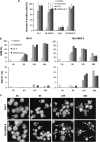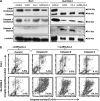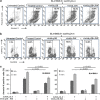Reversion of apoptotic resistance of TP53-mutated Burkitt lymphoma B-cells to spindle poisons by exogenous activation of JNK and p38 MAP kinases
- PMID: 24787013
- PMCID: PMC4047855
- DOI: 10.1038/cddis.2014.150
Reversion of apoptotic resistance of TP53-mutated Burkitt lymphoma B-cells to spindle poisons by exogenous activation of JNK and p38 MAP kinases
Abstract
Defects in apoptosis are frequently the cause of cancer emergence, as well as cellular resistance to chemotherapy. These phenotypes may be due to mutations of the tumor suppressor TP53 gene. In this study, we examined the effect of various mitotic spindle poisons, including the new isocombretastatin derivative isoNH2CA-4 (a tubulin-destabilizing molecule, considered to bind to the colchicine site by analogy with combretastatin A-4), on BL (Burkitt lymphoma) cells. We found that resistance to spindle poison-induced apoptosis could be reverted in tumor protein p53 (TP53)-mutated cells by EBV (Epstein Barr virus) infection. This reversion was due to restoration of the intrinsic apoptotic pathway, as assessed by relocation of the pro-apoptotic molecule Bax to mitochondria, loss of mitochondrial integrity and activation of the caspase cascade with PARP (poly ADP ribose polymerase) cleavage. EBV sensitized TP53-mutated BL cells to all spindle poisons tested, including vincristine and taxol, an effect that was systematically downmodulated by pretreatment of cells with inhibitors of p38 and c-Jun N-terminal kinase (JNK) mitogen-activated protein kinases. Exogenous activation of p38 and JNK pathways by dihydrosphingosine reverted resistance of TP53-mutated BL cells to spindle poisons. Dihydrosphingosine treatment of TP53-deficient Jurkat and K562 cell lines was also able to induce cell death. We conclude that activation of p38 and JNK pathways may revert resistance of TP53-mutated cells to spindle poisons. This opens new perspectives for developing alternative therapeutic strategies when the TP53 gene is inactivated.
Figures







Similar articles
-
Taxol-induced mitochondrial stress in melanoma cells is mediated by activation of c-Jun N-terminal kinase (JNK) and p38 pathways via uncoupling protein 2.Cell Signal. 2008 Feb;20(2):311-22. doi: 10.1016/j.cellsig.2007.10.015. Epub 2007 Oct 17. Cell Signal. 2008. PMID: 18068334
-
The role of mitogen-activated protein kinase in cadmium-induced primary rat cerebral cortical neurons apoptosis via a mitochondrial apoptotic pathway.J Trace Elem Med Biol. 2015 Jan;29:275-83. doi: 10.1016/j.jtemb.2014.06.006. Epub 2014 Jun 24. J Trace Elem Med Biol. 2015. PMID: 25043952
-
Sphingosine-1-phosphate-induced ERK activation protects human melanocytes from UVB-induced apoptosis.Arch Pharm Res. 2003 Sep;26(9):739-46. doi: 10.1007/BF02976685. Arch Pharm Res. 2003. PMID: 14560924
-
Epicatechin gallate induces cell death via p53 activation and stimulation of p38 and JNK in human colon cancer SW480 cells.Nutr Cancer. 2013;65(5):718-28. doi: 10.1080/01635581.2013.795981. Nutr Cancer. 2013. PMID: 23859040
-
Evolutionary determinants of curability in cancer.Nat Ecol Evol. 2023 Nov;7(11):1761-1770. doi: 10.1038/s41559-023-02159-w. Epub 2023 Aug 24. Nat Ecol Evol. 2023. PMID: 37620552 Review.
Cited by
-
Exposure of Breast and Lung Cancer Cells to a Novel Estrone Analog Prior to Radiation Enhances Bcl-2-Mediated Cell Death.Int J Mol Sci. 2018 Sep 23;19(10):2887. doi: 10.3390/ijms19102887. Int J Mol Sci. 2018. PMID: 30249026 Free PMC article.
-
Targeting of non-apoptotic cancer cell death mechanisms by quercetin: Implications in cancer therapy.Front Pharmacol. 2022 Nov 16;13:1043056. doi: 10.3389/fphar.2022.1043056. eCollection 2022. Front Pharmacol. 2022. PMID: 36467088 Free PMC article. Review.
-
Smac mimetics and TRAIL cooperate to induce MLKL-dependent necroptosis in Burkitt's lymphoma cell lines.Neoplasia. 2021 May;23(5):539-550. doi: 10.1016/j.neo.2021.03.003. Epub 2021 May 7. Neoplasia. 2021. PMID: 33971465 Free PMC article.
-
Intracellular Signaling Responses Induced by Radiation within an In Vitro Bone Metastasis Model after Pre-Treatment with an Estrone Analogue.Cells. 2021 Aug 17;10(8):2105. doi: 10.3390/cells10082105. Cells. 2021. PMID: 34440874 Free PMC article.
-
Sphingolipids and Lymphomas: A Double-Edged Sword.Cancers (Basel). 2022 Apr 19;14(9):2051. doi: 10.3390/cancers14092051. Cancers (Basel). 2022. PMID: 35565181 Free PMC article. Review.
References
-
- Henson PM, Bratton DL, Fadok VA. Apoptotic cell removal. Curr Biol. 2001;11:R795–R805. - PubMed
-
- Green DR, Kroemer G. The pathophysiology of mitochondrial cell death. Science. 2004;305:626–629. - PubMed
-
- Kroemer G, Galluzzi L, Brenner C. Mitochondrial membrane permeabilization in cell death. Physiol Rev. 2007;87:99–163. - PubMed
-
- LaCasse EC, Mahoney DJ, Cheung HH, Plenchette S, Baird S, Korneluk RG. IAP-targeted therapies for cancer. Oncogene. 2008;27:6252–6275. - PubMed
MeSH terms
Substances
LinkOut - more resources
Full Text Sources
Other Literature Sources
Research Materials
Miscellaneous

